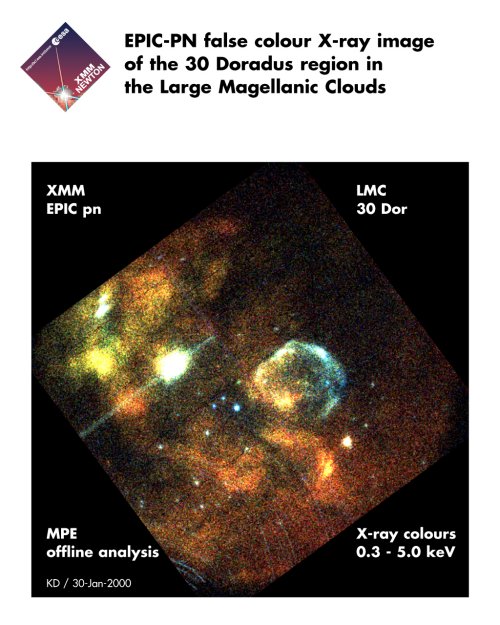XMM-Newton PN First Light - 30 Dor

Image and text courtesy of ESA
EPIC-PN false colour X-ray image of the 30 Doradus region in the large magellanic clouds
This X-ray colour image made with the EPIC camera on XMM shows part of a
small companion galaxy to the Milky Way, the Large Magellanic Cloud, where
stellar explosions are releasing newly manufactured elements, and new stars
are being formed. The image is made so as to reveal the temperature of the
X-ray emitting medium, with blue indicating the hottest regions; green the
intermediate temperatures and red the coldest regions. Most of the ?blue?
X-rays have not been observed before, and it is the collecting power of XMM
that enables these observations.
Get the high resolution version.
The expanding cauldon in the Large Magellanic Cloud
The Large Magellanic Cloud also known as the Nebula Major is about 20 thousand light years in diameter. Situated 160 thousand light years from Earth, it is one of two irregularly shaped galaxies that are easily seen with the naked eye in the southern hemisphere. These galaxies are satellites of the Milky Way and appear to be slowly spiralling into our own Galaxy.
The first image obtained by the EPIC-PN X-ray cameras viewed the 30 Doradus region of the Large Magellanic Cloud. Also called the Tarantula Nebula, 30 Doradus is a cauldron of creation where exploding stars are releasing vast amounts of matter and where new stars are being born. The image presents the million degree temperatures of the emitting medium, with blue indicating the hottest regions; green intermediate temperatures and red the coldest regions. The white and blue arc-like formation just off the centre is a new object, only part of which was known in the past. It has the appearance of a supernova remnant with its expanding glowing-hot gas producing X-ray emission as it collides with the interstellar medium.
On the lower right of the picture is the remains of a star that exploded as Supernova 1987A on 24 February 1987. It was the first supernova to reach naked-eye brightness since 1604 (Kepler's star) and remained visible to the naked eye for nearly nine months. The brightest source in the view, upper left, is another supernova remnant (N157D).
Martin Turner, Principal Investigator for the EPIC cameras: "These first pictures are tremendously exciting after so many years of work. They are all that we hoped they would be. In the LMC we can see the elements, which go to make up new stars and planets, being released in giant stellar explosions. We can even see the creation of new stars going on, using elements scattered through space by previous stellar explosions. This is what we built the EPIC cameras for and they are really fulfilling their promise."
If you have any questions concerning XMM-Newton send e-mail to xmmhelp@lists.nasa.gov



